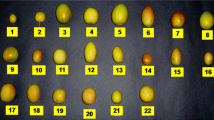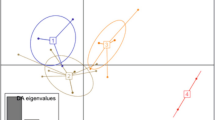Abstract
The morpho-physiological and molecular markers were used to reveal genetic diversity among 13 putative varieties of Punica granatum grown in India. A hybrid protocol of DNA isolation was developed to obtain high molecular weight quality genomic DNA. Ten RAPD primers generated 119 marker bands amounting to 92.44 % polymorphism with 88 % polymorphic information content. The 5.8S rRNA gene region was found to be highly conserved (99.34 %) followed by ITS-1 (96.58 %) and ITS-2 (89.21 %) intron regions encompassing the gene. ITS-2 region was recorded with the highest percentage of parsimony informative sites with high divergence mainly due to SNPs. The PCA accounted for 84.21 % of total variance. The AMOVA of RAPD data revealed the maximum genetic variation within population rather than among populations. Nei’s gene diversity (h) was 0.2684 and Shannon information index (i) was 0.4135. The Nei’s genetic distance ranged from 0.0620 to 0.0878. The coefficient of gene differentiation between populations (Gst) of 0.2584 and gene flow (Nm) of 1.4347 validates that the main proportion of genetic variation was within populations. The present study validates the utility of ITS rDNA region as a reliable indicator of phylogenetic interrelationships, especially ITS-2 as probable DNA barcode at higher levels and can serve as an additional approach for genetic cataloguing of pomegranate germplasm for crop improvement.





Similar content being viewed by others
References
Harlan JR (1992) Crops and man (2nd ed). American Society of Agronomy and Crop Science Society of America, Madison, p 289
Levin GM (1994) Pomegranate (Punica granatum L.) plant genetic resources in Turkmenistan. Plant Gene Res Newslet 97:31–36
Levin GM (2006) Pomegranate roads: a Soviet botanist’s exile from Eden, 1st edn. Floreant Press, Forestville, pp 15–183
Melgarejo P, Salazar DM (2003) Tratado de fruticultura para zonas a′ ridas y semia′ ridas, Vol 2. Algarrobo, granado y jinjolero. Mundi-Prensa y AMV Ediciones, Madrid, p 430
Rajan S, Mahalakshmi S, Deepa VM, Sathya K, Shajitha S, Thirunalasundari T (2011) Antioxidant potentials of Punica granatum fruit rind extracts. Intl J Pharm Sci 3(3):82–88
Still DW (2006) Pomegranates: a botanical perspective. In: Seeram NP, Schulman RN, Heber D (eds) Pomegranates: ancient roots to modem medicine. CRC Press, Boca Raton, pp 199–209
Holland D, Hatib K, Bar-Yaakov I (2009) Pomegranate: botany, horticulture, breeding. Hortic Rev 35:127–191
Mansour E, Khaled AB, Haddad M, Abid M, Bachar K, Ferchichi A (2011) Selection of pomegranate (Punica granatum L.) in south-eastern Tunisia. Afr J Biotechnol 10(46):9352–9361
Ozgen M, Durgac C, Serce S, Kaya C (2008) Chemical and antioxidant properties of pomegranate cultivars grown in Mediterranean region of Turkey. Food Chem 111:703–706
Tehranifara A, Zareia M, Nematia Z, Esfandiyaria B, Vazifeshenasb MR (2010) Investigation of physico-chemical properties and antioxidant activity of twenty Iranian pomegranate (Punica granatum L.) cultivars. Sci Hortic 126:180–185
Williams JGK, Kubelik AR, Livak KJ, Rafalski JA, Tingey SV (1990) DNA polymorphism amplified by arbitrary primers are useful as genetic markers. Nucleic Acids Res 18:6531–6535
Souza IGB, Valente SES, Britto FB, de Souza VAB, Lima PSC (2011) RAPD analysis of the genetic diversity of mango (Mangifera indica) germplasm in Brazil. Genet Mol Res 10(4):3080–3089
El-Mouei R, Choumane W, Dway F (2011) Characterization and estimation of genetic diversity in Citrus rootstocks. Int J Agric Biol 13:571–575
Sarkhosh A, Zamani Z, Fatahi R, Ranjbar H (2009) Evaluation of genetic diversity among Iranian soft-seed pomegranate accessions by fruit characteristics and RAPD markers. Sci Hortic 121:313–319
Narzary D, Mahar KS, Rana TS, Ranade SA (2009) Analysis of genetic diversity among wild pomegranates in Western Himalayas, using PCR methods. Sci Hortic 121:237–242
Jbir R, Hasnaoui N, Mars M, Marrakchi M, Trifi M (2008) Characterization of Tunisian pomegranate (Punica granatum L.) cultivars using amplified fragment length polymorphism analysis. Sci Hortic 115:231–237
Narzary D, Rana TS, Ranade SA (2010) Genetic diversity in inter-simple sequence repeat profiles across natural populations of Indian pomegranate (Punica granatum L.). Plant Biol 12:806–813
Pirseyedi SM, Valizadehghan S, Mardi M, Ghaffari MR, Mahmoodi P, Zahravi M, Zeinalabedini M, Nekoui SMK (2010) Isolation and characterization of novel microsatellite markers in pomegranate (Punica granatum L.). Int J Mol Sci 11:2010–2016
Alvarez I, Wendel JF (2003) Ribosomal ITS sequences and plant phylogenetic inference. Mol Phylogenet Evol 29:435–455
Singh SK, Tiwari M, Kamal S, Yadav MC (2005) Morel phylogeny and diagnostics based on restriction fragment length polymorphism analysis of ITS region of 5.8S ribosomal DNA. J Biochem Biotechnol 14:179–183
Kakani RK, Singh SK, Pancholy A, Meena RS, Pathak R, Raturi A (2011) Assessment of genetic diversity in Trigonella foenumgraecum based on nuclear ribosomal DNA, internal transcribed spacer and RAPD analysis. Plant Mol Bio Rep 29:315–323
Saini A, Reddy SK, Jawali N (2008) Intra individual and intra species heterogeneity in nuclear rDNA ITS region of Vigna species from subgenus Ceratotropis. Genet Res 90:299–316
Baldwin BG, Sanderson MJ, Porter JM, Wojciechowski MF, Campbell CS, Donoghue MJ (1995) The ITS region of nuclear ribosomal DNA: a valuable source of evidence on angiosperm phylogeny. Ann Mol Bot Gard 82:247–277
Jorgenson RD, Cluster PD (1988) Modes and tempos in the evolution of nuclear ribosomal DNA: new characters of evolutionary studies and new markers for genetic and population studies. Ann Mo Bot Gard 75:1238–1247
Mir BA, Koul S, Kumar A, Koul MK, Soodan AS, Raina SN (2010) Intraspecific variation in the internal transcribed spacer (ITS) regions of rDNA in Withania somnifera (Linn.) Dunal. Indian J Biotechnol 9:325–328
Carvalho A, Guedes-Pinto H, Lima BJ (2009) Genetic diversity among old Portuguese bread wheat cultivars and botanical varieties evaluated by ITS rDNA PCR-RFLP markers. J Genet 88(3):363–367
Andrew M, Kohn Linda M (2009) Single nucleotide polymorphism based diagnostic system for crop-associated Sclerotinia species. Appl Environ Microbiol 75:5600–5606
Xiao LQ, Moller M, Zhu H (2010) High nrDNA ITS polymorphism in the ancient extant seed plant cycas: incomplete concerted evolution and the origin of pseudogenes. Mol Phylogenet Evol 55:168–177
Doyle JJ, Doyle JL (1990) Isolation of plant DNA from fresh tissue. Focus 12(1):13
White TJ, Bruns SL, Taylor J (1990) Amplification and direct sequencing of fungal ribosomal RNA genes for phylogenetics. In: Innes MA, Gelfand DH, Sninsky JJ, White TJ (eds) PCR protocols, a guide to methods and applications. Academic Press, San Diego, pp 315–322
Nicholas KB, Nicholas HB, Deerfield DW (1997) GeneDoc: analysis and visualization of genetic variation. Embnew News 4:14
Perrière G, Gouy M (1996) WWW-Query: an on-line retrieval system for biological sequence banks. Biochimie 78:364–369
Rohlf FJ (1997) NTSYS pc: numerical taxonomy and multivariate analysis system Version 2.02h. Exeter software, New York
Smith JSC, Chin ECL, Shu H, Smith OS, Wall SJ, Senior ML, Mitchell SE, Kresovich S, Zeigle J (1997) An evaluation of the utility of SSR loci as molecular markers in maize (Zea mays L.): comparison with data from RFLPs and pedigree. Theor Appl Genet 95:163–173
Peakall R, Smouse PE (2006) GENALEX 6: genetic analysis in Excel. Population software for teaching and research. Mol Ecol Notes 6:288–295
Lewontin RC (1972) The apportionment of human diversity. Evol Biol 6:391–398
Nei M (1973) Analysis of gene diversity in subdivided populations. Proc Natl Acad Sci USA 70:3321–3323
Noormohammadi Z, Fasihee A, Homaee-Rashidpoor S, Sheidai M, Baraki SG, Mazooji A, Tabatabaee-Ardakani SZ (2012) Genetic variation among Iranian pomegranates (Punica granatum L.) using RAPD, ISSR and SSR markers. Aust J Crop Sci 6(2):268–275
Bedaf MT, Bahar M, Sharifnabi B, Yamchi A (2011) Evaluation of genetic diversity among Iranian pomegranate (Punica granatum L.) cultivars, using ISSR and RAPD markers. Taxon Biosyst 3(8):35–44
Ercisli S, Kafkas E, Orhan E, Kafkas S, Dogan Y, Esitken A (2011) Genetic characterization of pomegranate (Punica granatum L.) genotypes by AFLP markers. Biol Res 44:345–350
Melgarejo P, Martinez JJ, Hernandez F, Martinez R, Legua P, Oncina R, Martinez-Murcia A (2009) Cultivar identification using 18S–28S rDNA intergenic spacer-RFLP in pomegranate (Punica granatum L.). Sci Hortic 120:500–503
Hasnaoui N, Mars M, Chibani J, Trifi M (2010) Molecular polymorphism in Tunisian pomegranate (Punica granatum L.) as revealed by RAPD fingerprints. Diversity 2:107–114
Soleimani MH, Talebi M, Sayed-Tabatabaei BE (2012) Use of SRAP markers to assess genetic diversity and population structure of wild, cultivated, and ornamental pomegranates (Punica granatum L.) in different regions of Iran. Plant Syst Evol. doi:10.1007/s00606-012-0626-4
Moslemi M, Zahravi M, Bakhshi Khaniki G (2010) Genetic diversity and population genetic structure of pomegranate (Punica granatum L.) in Iran using AFLP markers. Sci Hortic 126:441–447
Raturi A, Singh SK, Sharma V, Pathak R (2012) Molecular characterization of Vigna radiata (L.) Wilczek genotypes based on nuclear ribosomal DNA and RAPD polymorphism. Mol Biol Rep 39(3):2455–2465
Barkley NA, Wang ML, Gillaspie AG, Dean RE, Pederson GA, Jenkins TM (2008) Discovering and verifying DNA polymorphisms in a mungbean [V. radiata (L.) R Wilczek] collection by EcoTILLING and sequencing. BMC Res Notes 1:28
Yuan ZH, Yin Y, Qu J, Zhu L, Li Y (2007) Population genetic diversity in Chinese pomegranate (Punica granatum L.) cultivars revealed by fluorescent-AFLP markers. J Genet Genomics 34(12):1061–1071
Sarkhosh A, Zamani Z, Fatahi R, Ebadi A (2006) RAPD markers reveal polymorphism among some Iranian pomegranate genotypes. Sci Hortic 111:24–29
Ercisli S, Agar G, Orhan E, Yildirim N, Hizarcic Y (2007) Interspecific variability of RAPD and fatty acid composition of some pomegranate cultivars (Punica granatum L.) growing in Southern Anatolia region in Turkey. Biochem Syst Ecol 35(11):764–769
Zamani Z, Sarkosh A, Fatahi R, Ebadi A (2007) Genetic relationships among pomegranate genotypes studied by fruit characteristics and RAPD markers. J Hortic Sci Biotechnol 82:11–18
Durgac C, Ozgen M, Simsek O, Kacar YA, Kiyga Y, Celebi S, Gunduz K, Serce S (2008) Molecular and pomological diversity among pomegranate (Punica granatum L.) cultivars in Eastern Mediterranean region of Turkey. Afr J Biotechnol 7:1294–1301
Acknowledgments
The authors are thankful to Dr. M. M. Roy Director, Central Arid Zone Research Institute, Jodhpur for providing necessary laboratory and field facilities to carry out this study.
Author information
Authors and Affiliations
Corresponding author
Rights and permissions
About this article
Cite this article
Singh, S.K., Meghwal, P.R., Pathak, R. et al. Genetic Diversity in Punica granatum Revealed by Nuclear rRNA, Internal Transcribed Spacer and RAPD Polymorphism. Natl. Acad. Sci. Lett. 36, 115–124 (2013). https://doi.org/10.1007/s40009-013-0120-8
Received:
Revised:
Accepted:
Published:
Issue Date:
DOI: https://doi.org/10.1007/s40009-013-0120-8




